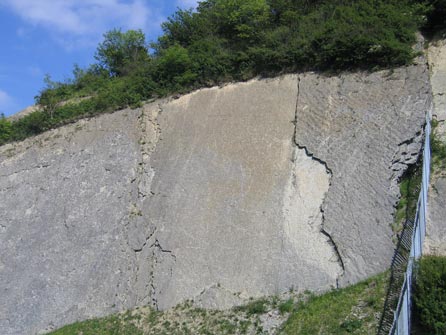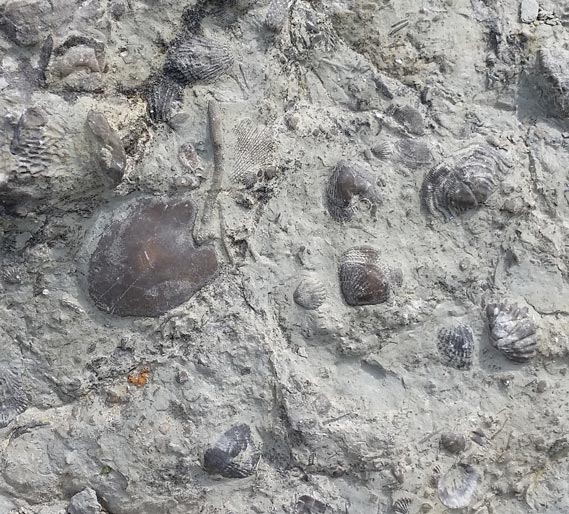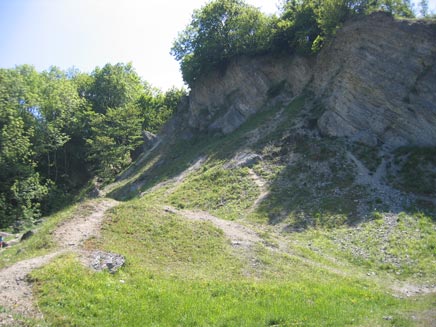Wren’s Nest and School Trips
Everything Dinosaur has been contacted by a school based in the West Midlands, seeking advice about a trip to the famous Wren’s Nest National Nature Reserve, a place we know very well indeed! This location is a popular destination for local schools which are studying fossils and rocks as part of the National Curriculum (England).
Visiting Wren’s Nest
Wren’s Nest is to the north-east of the town of Dudley and it is a designated SSSI (site of special scientific interest), so no hammering at the cliffs of this former quarry is allowed. However, lots of fossils are being washed out of the scree slopes and there is something like seven hundred different types of fossil to collect, nearly ninety of which are unique to the Wren’s Nest area.
The Famous Ripple Beds at Wren’s Nest
Picture credit: Everything Dinosaur
The picture above shows the famous “Ripple Bed Hill” at Wren’s Nest. This near vertical cliff face was once at the bottom of a shallow sea. The “ripples” are the preserved remains of wave action on the seabed, they are around 426 million years old. Taking schoolchildren to this location, helps them to gain an appreciation of deep, geological time.
How Did the Ripple Beds Form?
These structures formed as a result of massive, probably seasonal storms that swept across the normally, relatively calm sea. The huge waves generated by the storm, led to the seabed being disturbed, the waves created by the storm had much more energy and their effect was felt much deeper in the tropical sea than usual. Sand and debris was picked up and washed backwards and forwards over the seabed, creating the ripples.
The seabed was nearly 100 feet (thirty metres), under water and normally it would have been unaffected by usual sea conditions. However, the symmetrical ripples are evidence of storm damage to this part of the seabed back in the Late Silurian.
Preserving Invertebrates as Fossils
After the storm had passed, the sea would have once again returned to its relatively calm state. Thirty metres down the seabed was once again protected by the effects of normal-sized waves, which could not penetrate deep enough to wipe away the ridges and ripples caused by the storm. Crinoids, (sea-lilies) soon colonised this part of the sea floor. However, sometime later, perhaps a few months, or perhaps after several years a large amount of mud was dumped on top of the ripples, permitting their preservation. The mud could have been deposited as a result of exceptional run-off from the land, or perhaps an earthquake or other seismic event led to a large amount of sediment being shifted.
Whatever, the cause the ripples (and the crinoids living on them), were buried. Palaeontologists have identified a total of twenty-five ripple bed areas in the cliffs that make up this feature of Wren’s Nest. Each ripple bed represents a separate storm event.
Fossils Galore to be Found
Picture credit: Everything Dinosaur
For replicas of iconic animals from the fossil record and creative toys and games: Replicas of Iconic Fossil Animals and Dinosaur Toys and Games.
Top Tips for a School Visit to Wren’s Nest
The site represents the remains of an ancient coral ecosystem dating between 423-426 million years ago (mya), it is Silurian in age and more than 700 different types of fossils have been found at this site. A party of schoolchildren will not collect them all, but they are bound to find plenty of fossils to satisfy curious minds. However, finding your own Trilobite fossil, a “Dudley Bug” Calymene blumenbachii, is most unlikely but you might find a fragment of the exoskeleton, a piece shed when the animal moulted.
• This is an SSSI (site of special scientific interest), no hammers or tools of any kind are permitted on site. However, you don’t need any tools as the constantly eroding scree provides lots of fossils that can simply be picked up.
• There are no toilet facilities at this location.
• A mid-week visit is best, either quite early in the morning or in the afternoon, although, the area tends not to be that busy at most times.
• When we visit we park close to the Caves Inn (car parking from 9.30am to 4pm Monday to Friday).
• The slopes are a magnet for young fossil hunters who love to try to climb them (and run up and down them), these slopes are very steep and very slippery after rain, so sensible precautions need to be taken.
• There is a slight risk of rock falls, after all, this is an old quarry site, but in all our visits, we have never seen any evidence of this.
• Contact Wren’s Nest here: Further information about Wren’s Nest. You might even be able to arrange short talk by one of the very knowledgeable wardens.
Typical Scree Slope at Wren’s Nest
Picture credit: Everything Dinosaur
Visit Everything Dinosaur’s award-winning website: Everything Dinosaur.









Leave A Comment